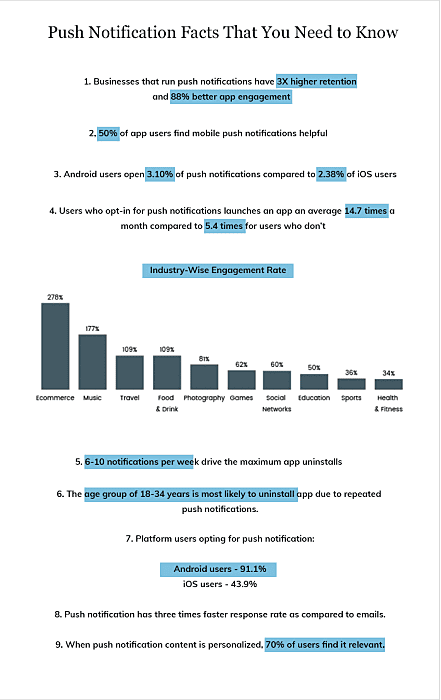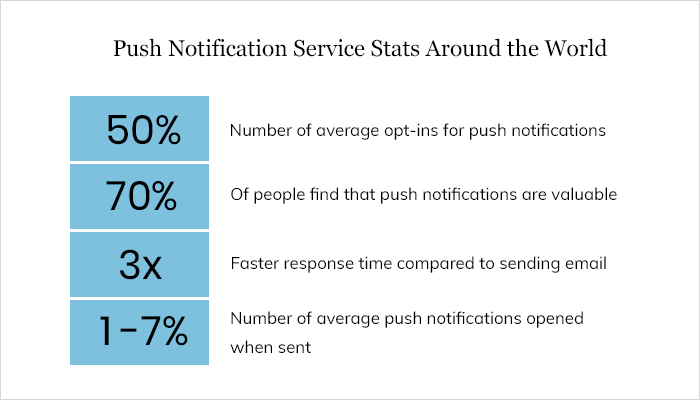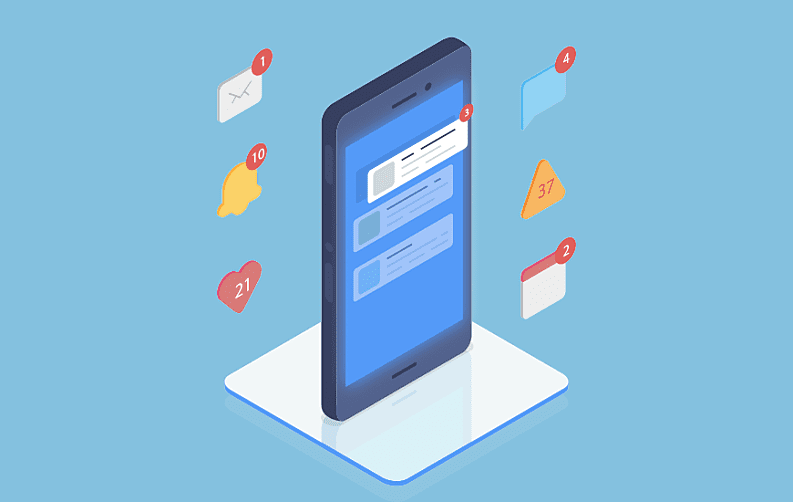
The flow of apps in the app store is never-ending. Already millions of apps are available on the app stores, and thousands of more apps are added on a daily basis. It brings the mobile app industry to a point where the failure rate well exceeds the success rate.
So, to stand out, many new technologies are tried and apps are stuffed with the latest features and mobile app trends that help it in making it more relevant to the user. And one such element that is widely used to engage with the user is ‘Push Notification.’
Push notification technology is similar to text messages that are delivered even when the mobile device is locked so that the user stays up-to-date with the app new announcements.
The actual potential of push notifications was witnessed by the app development industry only a couple of years back. Before that, the email marketing strategy was considered better than the push notification platforms mainly by the app marketing companies, as email marketing was receiving three times faster response from the users.
With many changes introduced in the push notification landscape, the metrics of sending information to the user has transformed altogether.
What are Push Notifications?
Are you juggling with questions like ‘what's a push notification’ or ‘what is a push alert?’ Well, here is the answer.
Push notification is a way to alert the user through their mobile device with significant content that might be of interest. This feature is integrated into the mobile application by the mobile app developers, as it establishes a continuous interaction between the user and app, even when the user is not using the app.
The best thing about push notification is that it doesn’t require any additional application to work. The receiver can see notification even if the device is locked or even if the app is not running.
Now, almost every app offers an option for push notification during the time of installation and if the push notification app is of your regular use, we advise you to opt-in to receive push notifications. There is always an option to revoke notification service at any time.
How Push Notification Came into Force?
Apple Push Notification Service or APNS was first launched in 2009 and Google made it a point to capitalize on push services for platforms like Android and iOS. It was the W3C Push API that had set new standards in the push notification field.
Apple sends push notification to increase the level of efficiency in the mobile application industry. The iOS user gets regular notifications about every elementary change and upgrades regarding the iOS platform and mobile applications on the platform itself.
Following stats exhibits the choice made by the user for opt-ins and using personalized push notification on Android and iOS platforms.
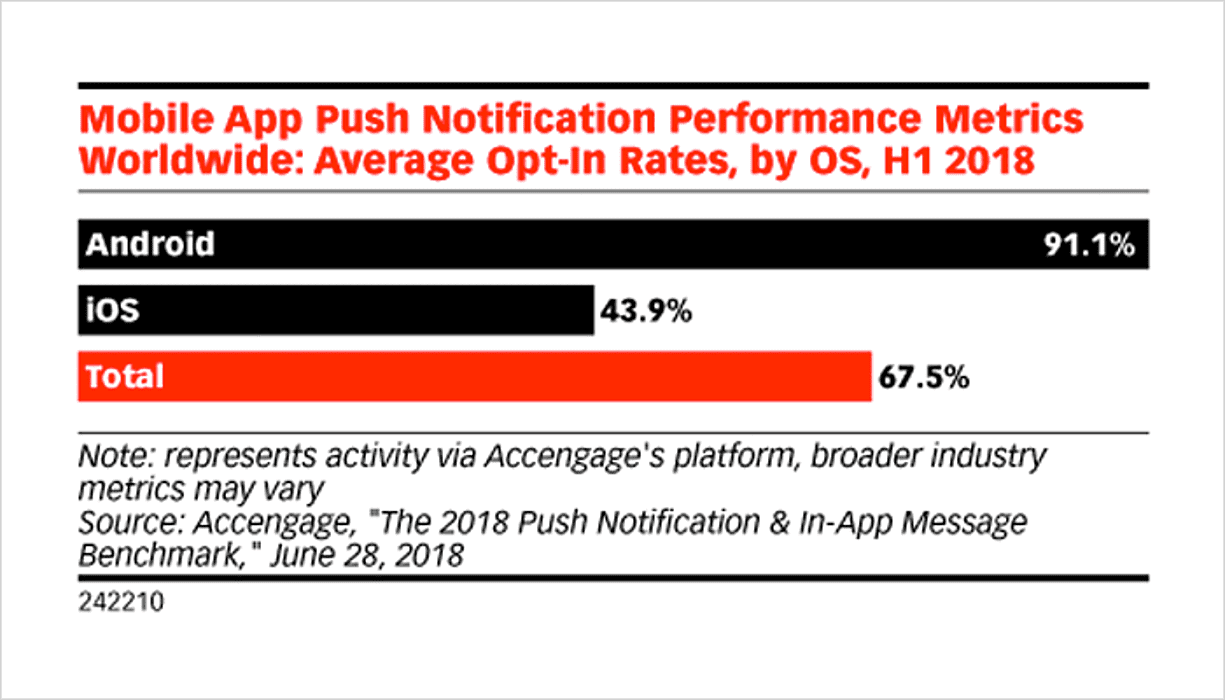
As per this research report by Accengage, an average of 67.5% of users opt-in for push messages. If we weigh the platforms, then it's Android that is favored the most with 91.1% of users opting for push notification, whereas, the iPhone users opt-in rate for push notifications is 43.9%.
How do I Stop Push Notifications?
To some users, push messages can be irksome due to various factors and then such users come across questions like ‘how do I get rid of notifications’ and ‘How do I block notifications on my phone?’ For such users, here is the answer.
Google has Google Cloud Messaging (also known as GCM) for Android users, which allows the user to activate or deactivate the free push notification service for all mobile apps installed on the users’ mobile phones.
Also, with Google Cloud Messaging, the user can adjust the push notification settings for each application separately, with which the user can only activate the push notification from his/her favorite app.
On the other hand, iOS users can directly turn off the app notifications from the Settings menu, by tapping on the Notification option. Once the app is found, open it and there comes an option which allows the user to turn off the notification service.
The rollout of iOS 12 made it easier to manage the notifications. The user can swipe down the notification from the screen and further change its behavior.
What are Push Notifications Benefits?
Push notification is one of the best tools to engage the user and offer several benefits, some of which are as follows:
- Cost: Unlike sending text messages, push notification doesn’t require a separate medium to send the notification and therefore, the investment in sending push notification stand to almost nil.
- User Control: A user can set preferences through mobile settings and notification centers on where and how they receive notifications. Hence, it reduces the risk of engaging in harassing messages and potential litigation due to annoying notifications.
- Risk Reduction: Push notifications are well within the guidelines of the Telephone Consumer Protection Act (TCPA), as it allows the user to opt-in/opt-out for the updates.
- Engagement: Push messages are an excellent technique to increase app engagement and improve retention rates.
- Brand consistency: Through push messages, last-minute deals, coupons, and special offers can be sent to the user, which tends to enhance the brand consistency because users always appreciate information that adds value.
- Conversion rates: Push notification can create a sense of urgency, which makes a positive impact on the conversion rate. It significantly works for the e-commerce apps which can use it to send notifications to the user who has not checked out after adding products in their kart.
- Track actionable metrics: With push notification, user behavior can be easily tracked by analyzing complex analytics on open rates, delivery receipts, open time, and engagement. Also, other data fields like interaction times and click-through rates are other significant elements of actionable metrics that can be deciphered with push notification services.
What are Push Notifications Challenges?
Push notification is need of the hour for the push notification service providers to communicate effectively with the user; still, there are some concerns that put people in jeopardy before sending the push notification or opting for the push notification services.
In the below graph, the respondents have given their view when they receive a push notification. The age group between 18 to 34 years strongly or somewhat agreed with 71% due to the annoyance caused by the push notification. The respondents are divided based upon their age group.
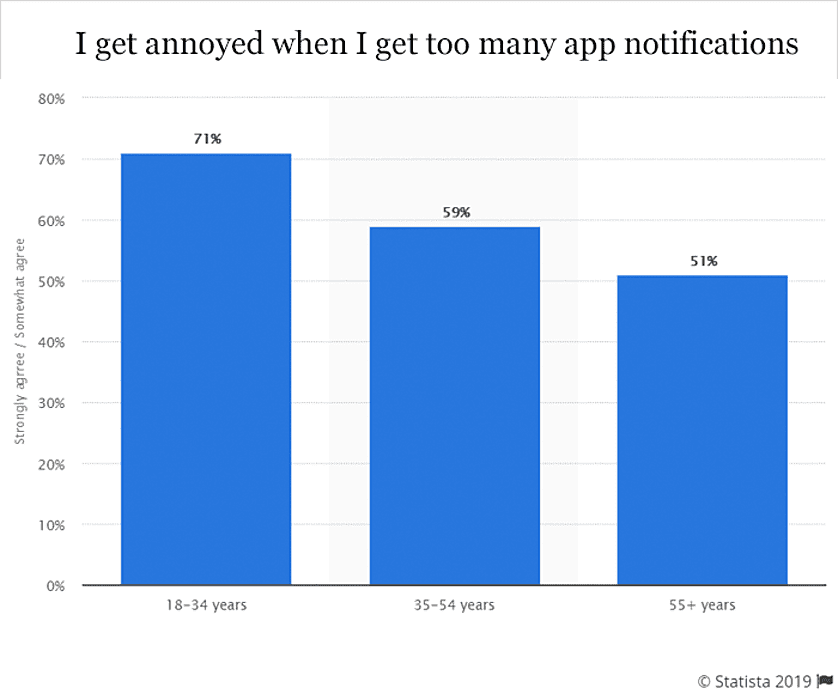
Credits: Statista
It’s not just the push notification that we receive that irks the user, but also the frequency in which the push notification is sent matters.
In another survey done by Statista, it’s clearly visible that the volume of push notifications forces the user to stop using the app.
The apps which send six to ten push notifications per week are most likely to get uninstalled from the device.
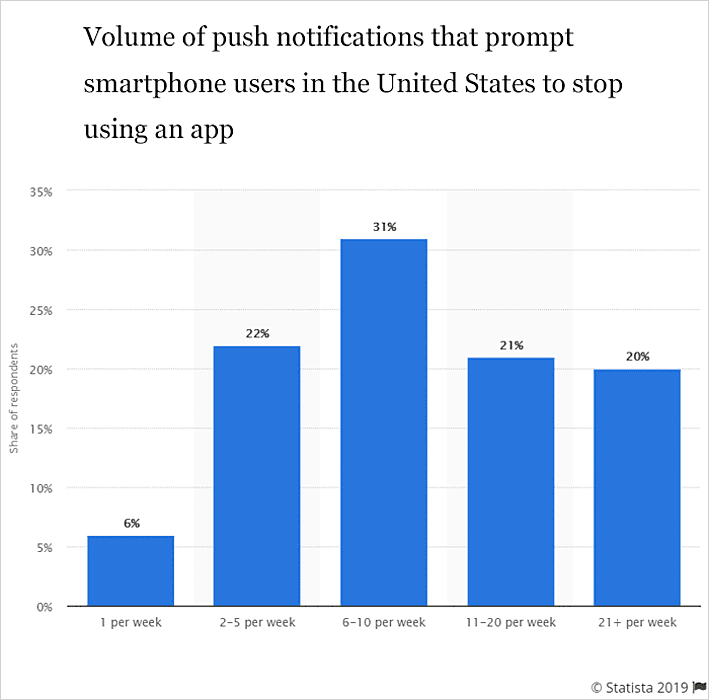
Credits: Statista
These stats should be taken as a caution and the push notification should be altered accordingly.
To make it a pleasant experience, the app publisher needs to understand what, when, and how frequently to push notification. For example, the user can be based in a different region or in a different time zone; therefore, it becomes necessary to learn their habits and sleep patterns.
By segmenting and personalizing the messages as per the user's need and mood will save the app publisher from flooding users with unwanted messaging.
In the below graph, you can see a significant difference in the percentage of open rates of messages with personalized content and non-personalized content.
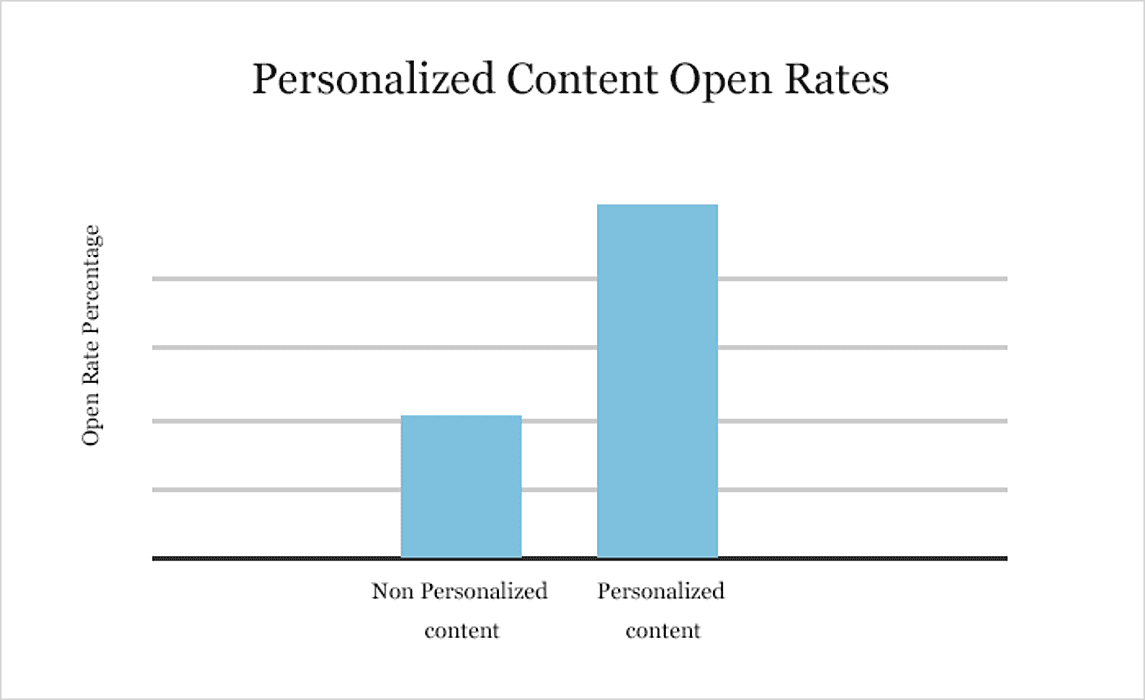
The team behind pushing the notification needs to understand that the aim of the push notification is not to market the brand but to provide value to the user.
Why is Push Notification Crucial in Mobile Apps?
With time, push notification has made its mark in the mobile app industry and app publishers made it a point to pop-up a dialogue box during the time of app installation and seek permission from the user to send push notification.
It manifests the significance of push notification in the mobile apps and to back this fact, we have come up with a few points, take a look:
1. Regulate More Interaction With the User
Push notifications help in maintaining the functionality of the app by conveying the latest updates and news within a specific limit using short and appropriate words. It keeps recalling the user about the app, which ultimately contributes to increasing the usability.
The time and again reminding tactic is also responsible for increasing the user engagement rate of the mobile application. Also, it can help in boosting app engagement.
2. Increase Engagement
If the app is well equipped with the push notification feature, the engagement statistics of the mobile app can favor drastically. With every alert of the latest news, events, contents instantly lead to a sudden hike in the user engagement rate.
This way, the application continuously notify the user with the latest updates, even when the user doesn't have much time to go through the app. It eventually escalates the involvement of the user with that particular mobile application
Some push notifications campaigns are so effective that it can directly increase the user engagement rate for the mobile application. Along with this, the publisher can even try different methods to deliver push notifications.
3. Drives High Traffic
Push notifications not only increases the interaction but also helps in boosting the traffic. The instant ping on the device pushes the user to open it up and which ultimately drives the app’s traffic.
Apprising the user with desired content instantly and regularly will automatically raise the bar of your traffic counts. However, these push notifications neither should be too sporadic nor too frequent as then the apps start to lose the interest of the end-user.
Another thing that the app publisher needs to keep in mind is the content that they are sharing. Until the user doesn’t get exciting content, he won’t click on the notification and it may lead to app uninstallation.
4. Insight into Customers Behavior
Push notification aids in collecting valuable information about the user by tracking push notification messages, interaction times, duration of interaction, situations, devices, platforms and generate maximum engagement and traffic.
The information like when, why and how many times the user uses your app will help you in serving the user in the best way through these notifications.
5. Ease of Use
In comparison to other means of interacting with customers like emails and text messages, push notifications are much more efficient and simpler. These notifications deliver specific information with much more clarity in limited words.
Push notifications are less complicated and are also easy to manage with the user-friendly interface, which conveys the message in a much more effective way. From a developer point of view push notifications are easy to produce and implement in the app.
For iOS, Swift is used to fuse mobile push notification services and Ionic is mostly preferred by the developers for Android. The end-users just need to scroll down their notification bar and decide what they want to do with the notification. Push Notifications are also very efficient in increasing your user retention rate for a mobile app.
Wrapping Up
If you want to make your mobile app more effective as well as interactive, then push notification is mandatory. This is because the app users rely on the features of push notifications in all apps to get regular alerts which can further save their time and effort. Therefore, a mobile app without push notification won't be able to survive for too long in the user's smartphone.
I hope this article helped you in understanding the importance of push notifications in mobile applications.
For more similar insights into the mobile industry world, subscribe to MobileAppDaily and make sure to leave your comment below to offer us your thoughts on the information shared by us.
